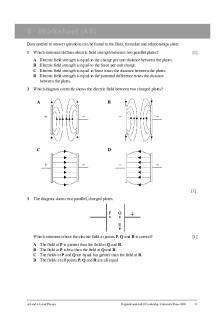Erector Spinae Worksheet PDF PDF

| Title | Erector Spinae Worksheet PDF |
|---|---|
| Author | Parth Patel |
| Course | Human Anatomy And Physiology I |
| Institution | University of Illinois at Chicago |
| Pages | 4 |
| File Size | 400.9 KB |
| File Type | |
| Total Downloads | 20 |
| Total Views | 122 |
Summary
lab 3 fractional distillation.docx
lab 6 shivam.docx
Lab 7 shivam patel.docx
LAb 8 shivam.docx
lab 10.docx
Lab report 1 orgo shivam.docx
Lab report 2 orgo lab.docx
Lab report 4 steam distillation.docx
Lab report 5 orgo lab.doc
la...
Description
12 QUESTIONS ON THE ERECTOR SPINAE AND RELATED MUSCLES. TURN IN Q. 7, 10 AND 12.
1). Circle the erector spinae from above and state another name for erector spinae? ERECTOR SPINAE MUSCLES (SPINALIS, LONGISSIMUS, ILIOCOSTALIS) ACTION: extends spine REFERRAL: back, ilium, sacrum COMMENTS: The erector spinae group is made up of three muscles, the spinalis most medially, the longissimus in the center, and iliocostalis laterally. The spinalis is just next to the spine, hard to palpate and often ignored, is but important. The longissimus is the main meat of the erector group, and is palpable as a taught rope half an inch lateral to the spine. The main attachment of the iliocostalis is to the ilium and ribs. Because of its lateral position, a tight iliocostalis can bring a hip up, or bring the ribcage down toward the hip.
Lateral Column Iliocostalis I. lumborum I. dorsi I. cervicis
Intermediate Column Longissimus L. dorsi L. cervicis L. capitis
Medial Column Spinalis S. dorsi S. cervicis S. capitis
Questions: 2). In the above boxes, what does I stand for? 3). L? 4). S? 5). Thus, are ALL the muscles on this page considered erector spinae?
6). Are the SEMISPINALE MUSCLES (described next) considered ERECTOR SPINAE MUSCLES? Semispinales muscles: any of the deep muscles just to either side of the spine that arise from the transverse processes (side projections) of the lower vertebrae and reach upward across several vertebrae to insert at the spines of vertebrae farther up, except for the upper segment (semispinalis capitis), which inserts at the occipital bone of the skull. The lower and middle segments (semispinalis dorsi and semispinalis cervicis) help extend (bend backward) and rotate the spinal column; the upper segment also helps bend the head backward.
7). Reproduce a chart of the ERECTOR SPINAE MUSCLES on a separate sheet of paper and turn it in.
8). Name three muscles in today’s lab which are considered helping the erector spinae (but are not categorized as erector spinae muscles, themselves).
9). Are the three muscles below (splenius cervicis, etc.) considered ERECTOR SPINAE? 10).What muscle(s) is/are being palpated? (Turn this question in, along with Q, 7 and 12).
11). Describe the origin and insertion of the rotatores muscle, using your lab book. Circle the rotators muscle found in this handout, and say whether the illustration is consistent or inconsistent with the information and illustration in your lab book.
o Both Sides [2, 3] Rotation o Rotation right [Right 2, 3] o Rotation left [Left 2, 3] Lateral Flexion o Lateral flexion right [Right 2, 3 ] o Lateral flexion left [Left 2, 3]
ERECTOR SPINAE DETAILS: Other Names “Lower Back Muscles” It is also known as sacrospinalis in older texts. A more modern term is extensor spinae,[1] though this is not in widespread use. The name of the muscle is pronounced e-rec-tor speen-aye, or e-rec-tor spinae-ee. Heads
Attachments Origin
1. Iliocostalis
Sacrum
Lumborum Thoracis Cervicis 2. Longissimus o Thoracis o Cervicis o Capitis 3. Spinalis o Thoracis o Cervicis o Capitis
Lower Posterior Surface [1] Transverse Processes [2] Ribs (Posterior) [1] Lumbar Vertebrae o Transverse Processes [2] Thoracic Vertebrae o Transverse Processes [2, 3] Cervical Vertebrae o Transverse Processes [3] Ligamentum Nuchae (Posterior Neck Ligaments) [3]
o o o
o o
Insertion
Movement Spine (Lumbar, Thoracic) Extension [1, 2, 3] Lateral Flexion [1] Rotation [1] Spine (Cervical) Extension [1, 2, 3] Lateral Flexion [1, 2] Rotation [1, 2]
Ribs (Posterior) [1] Cervical Vertebrae o Transverse Processes [1, 2] o Spinous Processes [3] Thoracic Vertebrae o Transverse Processes [2] o Spinous Processes [3] Skull o Mastoid Process [2] o Occipital Bone [3] Related Muscles
Neck (Atlantooccipital & Atlantoaxial) Extension
o o
12). OPEN BOOK CHALLENGE: Name the muscle(s) on the… Left and Right sides And discuss their origin, Insertion and action. Same muscle? Can you demonstrate action of both/each? L and R? Write answer in on separate Sheet of paper and turn it in along with #7. Write your name on that paper, please.
Splenius Quadratus Lumborum...
Similar Free PDFs

Erector Spinae Worksheet PDF
- 4 Pages

Cell Types Worksheet PDF
- 9 Pages

Worksheet
- 2 Pages

Worksheet#7(1) - worksheet
- 3 Pages

- 9 Pages

Common Good PDF - pdf
- 7 Pages
Popular Institutions
- Tinajero National High School - Annex
- Politeknik Caltex Riau
- Yokohama City University
- SGT University
- University of Al-Qadisiyah
- Divine Word College of Vigan
- Techniek College Rotterdam
- Universidade de Santiago
- Universiti Teknologi MARA Cawangan Johor Kampus Pasir Gudang
- Poltekkes Kemenkes Yogyakarta
- Baguio City National High School
- Colegio san marcos
- preparatoria uno
- Centro de Bachillerato Tecnológico Industrial y de Servicios No. 107
- Dalian Maritime University
- Quang Trung Secondary School
- Colegio Tecnológico en Informática
- Corporación Regional de Educación Superior
- Grupo CEDVA
- Dar Al Uloom University
- Centro de Estudios Preuniversitarios de la Universidad Nacional de Ingeniería
- 上智大学
- Aakash International School, Nuna Majara
- San Felipe Neri Catholic School
- Kang Chiao International School - New Taipei City
- Misamis Occidental National High School
- Institución Educativa Escuela Normal Juan Ladrilleros
- Kolehiyo ng Pantukan
- Batanes State College
- Instituto Continental
- Sekolah Menengah Kejuruan Kesehatan Kaltara (Tarakan)
- Colegio de La Inmaculada Concepcion - Cebu









